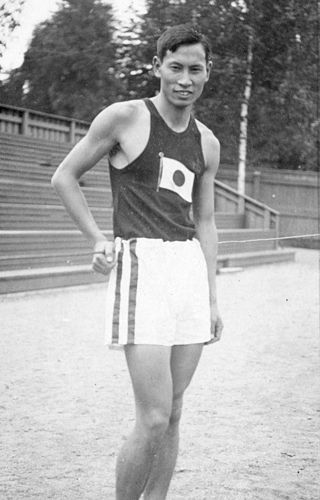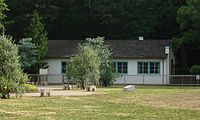
Shinjuku is a special ward in the Tokyo Metropolis in Japan. It is a major commercial and administrative center, housing the northern half of the busiest railway station in the world and the Tokyo Metropolitan Government Building, the administration center for the government of Tokyo. As of 2018, the ward has an estimated population of 346,235, and a population density of 18,232 people per km2. The total area is 18.23 km2. Since the end of the Second World War, Shinjuku has been a major secondary center of Tokyo (fukutoshin), rivaling the original city center in Marunouchi and Ginza. It literally means "New Inn Ward".

Shibuya is a special ward in the Tokyo Metropolis in Japan. As a major commercial and finance center, it houses two of the busiest railway stations in the world, Shinjuku Station and Shibuya Station.

Harajuku is a district in Shibuya, Tokyo. Harajuku is the common name given to a geographic area spreading from Harajuku Station to Omotesando, corresponding on official maps of Shibuya ward as Jingūmae 1 chōme to 4 chōme. In popular reference, Harajuku also encompasses many smaller backstreets such as Takeshita Street and Cat Street spreading from Sendagaya in the north to Shibuya in the south.

Meiji Shrine, is a Shinto shrine in Shibuya, Tokyo, that is dedicated to the deified spirits of Emperor Meiji and his wife, Empress Shōken. The shrine does not contain the emperor's grave, which is located at Fushimi-momoyama, south of Kyoto.

United States Forces Japan (USFJ) is a subordinate unified command of the United States Indo-Pacific Command (USINDOPACOM). It was activated at Fuchū Air Station in Tokyo, Japan, on 1 July 1957 to replace the Far East Command. USFJ is commanded by the Commander, US Forces Japan (COMUSJAPAN) who is dual-hatted as commander of the Fifth Air Force. U.S. Forces Japan is currently headquartered at Yokota Air Base in Tokyo.

Yoyogi Park is a park in Shibuya, Tokyo, Japan. It is located adjacent to Harajuku Station and Meiji Shrine in Yoyogikamizonochō. The park is a popular Tokyo destination, especially on Sundays when it is used as a gathering place for Japanese rock music fans, jugglers, comedians, martial arts clubs, cosplayers and other subculture and hobby groups. In spring, thousands of people visit the park to enjoy the cherry blossom during hanami. The landscaped park has picnic areas, bike paths, cycle rentals, public sport courts, and a dog run.
An Olympic Village is a residential complex built or reassigned for the Olympic Games in or nearby the host city for the purpose of accommodating all of the delegations. Olympic Villages are usually located close to the Olympic Stadium within an Olympic Park.

Yoyogi National Gymnasium, officially Yoyogi National Stadium is an indoor arena located at Yoyogi Park in Shibuya, Tokyo, Japan, which is famous for its suspension roof design.

Sendagaya (千駄ヶ谷) is an area within Shibuya ward, one of the 23 special wards of Tokyo.

Mikio Oda was a Japanese athlete and the first Japanese Olympic gold medalist. He was the first Asian Olympic champion in an individual event.

Yoyogi (代々木) is a neighbourhood in the northern part of Shibuya, Tokyo, Japan.

Yoyogi-Hachiman Station is a railway station on the Odakyu Odawara Line in Shibuya-ku, Tokyo, Japan, operated by the private railway operator Odakyu Electric Railway.

The Tokyo bid for the 2016 Summer Olympics and Paralympics was an unsuccessful bid, first recognized by the International Olympic Committee (IOC) on September 14, 2007. The IOC shortlisted four of the seven applicant cities—Chicago, United States; Madrid, Spain; Rio de Janeiro, Brazil; and Tokyo, Japan; over Baku, Azerbaijan; Doha, Qatar; and Prague, Czech Republic—on June 4, 2008 during a meeting in Athens, Greece. This was followed by an intensive bidding process which finished with the election of Rio de Janeiro at the 121st IOC Session in Copenhagen, Denmark, on October 2, 2009.
Tokyo is a major center for sports in Japan. Its professional sports teams compete in baseball, football (soccer), sumo and basketball. It hosted the 1964 Summer Olympics and 2020 Summer Olympics.

Tachikawa Airfield is an airfield in the city of Tachikawa, in the western part of Tokyo, Japan. Currently under the administration of the Ministry of Defense, it has also served as a civilian airport with Japan's first scheduled air service.

The Wheelchair rugby tournament at the 2020 Summer Paralympics in Tokyo, Japan was the seventh edition of Wheelchair rugby as a Paralympic sport since its debut as a demonstration sport at the 1996 Summer Paralympics in Atlanta. The competition was hosted at the Yoyogi National Stadium and was held from 25 to 29 August 2021.

Japan competed as the host nation of the 2020 Summer Paralympics in their capital Tokyo from 24 August to 5 September 2021.

France competed at the 2020 Summer Paralympics in Tokyo, Japan, from 24 August to 5 September 2021.

Shibuya Scramble Square is a mixed-use skyscraper connected to Shibuya Station in Shibuya, Tokyo, Japan.


















